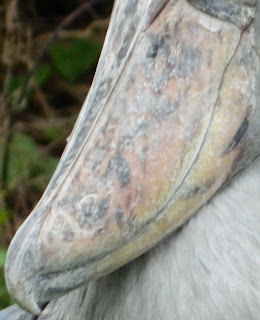If there is just one bird I would tell a non-birder to see, I would tell them to see a shoebill.
I remember first reading about the shoebill. It was spring 2008; Michele and I had just returned from our honeymoon in Ecuador. A short trip to the Amazon rainforest had shown us a couple things: first, that we knew nothing of the spectacular world of birds and second, that both of us were up for adventures. We started to make a list of all the places and animals we wanted to see in life. Wild gorillas and chimpanzees made that list.
 |
| Our first birdwatching experience was in the Amazon rainforest in Ecuador. After seeing parrots, toucans, herons, screamers, and all sorts of others, we were hooked on birds. |
Shortly thereafter, I stumbled across a trip to Uganda from the Birding Africa company called “Gorillas, chimps, and shoebill.” This seemed to satisfy both our primate interests and our growing interest in birds. But what the heck is a shoebill? We would soon find out, and the species has captivated us ever since.
My first look at a shoebill came in the American Museum of Natural History in New York. On the bottom floor of the African Mammals exhibit, just past the giant stuffed group of elephants, there is a display of the Nile River. Nile crocodiles and dozens of bird species accompany the hippos, but one bird stands center: a stuffed shoebill.
The shoebill is an odd bird. It stands at 1.2 meters (about 4 feet), making it taller than most herons and even some storks. But where herons and storks have thin necks and are pretty skinny birds, the shoebill is stout. It looks like the football player of birds. It is greyish blue, has a feathery tuft shooting out the back of its head, and has big pale eyes covered by pale eye-lids when it blinks. The most striking feature of the bird is its bill, from which its current common name is derived (it used to be called whale-billed stork). The bill is long, but again wide. It is shaped like a clog, the type you might expect to see on the foot of a traditional Dutch woman. At the very end of this shoe is a sharp hook. There is no other bird that looks similar.
There has been much discussion about which other birds the shoebill is most related. It was considered a stork for some time, but is now thought to be related to pelicans. It is however, placed in its own family in the taxonomic classification system (Domain-Kingdom-Phylum-Class-Order-Family-Genus-Species). For many birders, its uniqueness and classification are alone reasons to see it.
 |
| Shoebill habitat: tropical shallow, flooded marshes and swamps with floating vegetation like papyrus, reeds, and grasses. |
Another intriguing feature of this bird is its range and distribution. It specializes in feeding on the lungfish, catfish, tilapia, and water snakes that occupy marsh beds in central-eastern Africa. It mainly lives in the wetlands that surround the Nile River. This makes the bird fairly inaccessible. Of the 5,000-10,000 individual wild shoebills, up to 80% of the world’s population lives in marshes along the Nile in South Sudan. Swamps in northern Zambia and the Democratic Republic of the Congo may hold up to 1000 individuals each. Up to 500 live in a giant wetland area in western Tanzania, but the terrain prevents people from seeking it there. Supposedly up to 50 individuals live in Akagera Naitonal Park in Rwanda, but we have specifically gone for it there a couple of times and failed to see it. About 150 individuals live in Uganda, which is where most birders see it.
The shoebill is noted as being “one of the most sought after species” in the field guide to the birds of sub-Saharan Africa. A website dedicated to the top 50 birds of the world ranks it as number 20 (out of 10,000 species). We sought the shoebill not for birding glory but because it has captured our imagination for years; indeed, it was one of the reasons we decided to live in East Africa. Before moving to Rwanda, I made a list of the birds we should try to see. The shoebill was #1.
Since we live in neighboring Rwanda, we found that we could do the entire trip to Uganda without hiring a company to plan and coordinate.We planned our itinerary with the shoebill as the priority. We would start and stay at the most reliable site for 3 days or longer if we needed to (we had two weeks in Uganda planned). We had another site on our itinerary just in case we missed it at the first site. Yes, it's ok to say it, we are crazy birders. But the shoebill is one crazy bird.
 |
| We bought this small shoebill statue carved from wood by a local artisan, who is supported by the Mabamba Wetland EcoTourism Association. |
Since we live in neighboring Rwanda, we found that we could do the entire trip to Uganda without hiring a company to plan and coordinate.We planned our itinerary with the shoebill as the priority. We would start and stay at the most reliable site for 3 days or longer if we needed to (we had two weeks in Uganda planned). We had another site on our itinerary just in case we missed it at the first site. Yes, it's ok to say it, we are crazy birders. But the shoebill is one crazy bird.





No comments:
Post a Comment